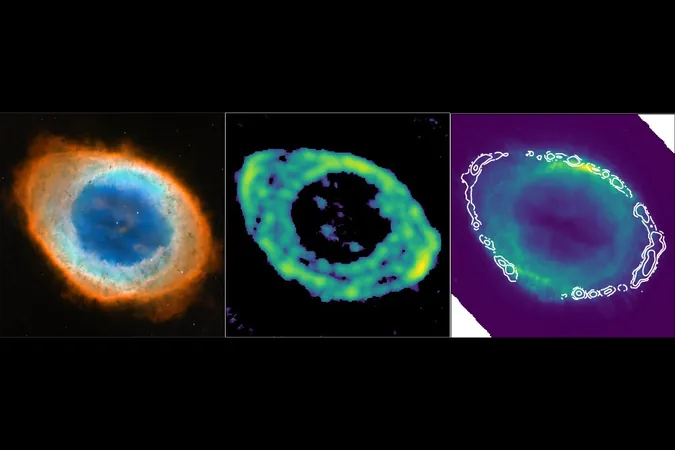
Revolutionary Research Unveils the True Shape of the Stunning Ring Nebula!
2025-01-14
Author: Olivia
Groundbreaking Study by Professor Joel Kastner
For over a century, the Ring Nebula has been a beacon of fascination for astronomers and stargazers alike, with its first image captured all the way back in 1886. Despite its iconic status, the true structure of this celestial masterpiece has remained shrouded in mystery—until now.
In a groundbreaking study led by Professor Joel Kastner at the Rochester Institute of Technology, a team of researchers has achieved the clearest three-dimensional view of the Ring Nebula to date. This pivotal discovery was made possible through advanced Submillimeter Array (SMA) radio wavelength mapping, which analyzed emissions from carbon monoxide (CO) gas surrounding the nebula.
Revealing the Ellipsoidal Structure
The striking results revealed that the Ring Nebula is not, as previously thought, a simple ring or bubble shape; instead, it boasts an ellipsoidal structure. "We looked at the data and the ellipsoidal structure was obvious, allowing us to create a straightforward geometrical model,” said Kastner. “The James Webb Space Telescope (JWST) provides a two-dimensional impression of the object, but the SMA enables us to measure the velocities of the molecular gas, exposing movements toward or away from us."
Astronomers had long debated the nebula's shape, speculating whether it resembled a ring or a soap bubble. However, the SMA data has definitively shown that the Ring Nebula is ellipsoidal, offering critical insights that images alone from the Hubble Space Telescope (HST) and JWST cannot reveal.
Historical Insights and an Intriguing Companion
The research also suggests that approximately 6,000 years ago, a red giant star expelled the molecular gas that currently envelops the nebula. Intriguingly, the data hints at the presence of a companion star influencing this dynamic, indicated by high-velocity gas blobs shooting out from both ends of the ellipsoidal shell.
Broader Implications for Stellar Evolution
This research echoes findings from earlier studies on the Southern Ring Nebula, enhancing our understanding of the structures surrounding dying stars. "The stars that create planetary nebulae like the Ring and Southern Ring might be responsible for a significant portion of the carbon found throughout the universe," Kastner explained. "By observing these exceptional objects, we can witness the journey of carbon as it is recycled into the formation of the next generation of stars and planets."
Conclusion: A Better Understanding of the Cosmos
The implications of this research are profound; not only does it alter our understanding of nebulae, but it also shines a light on the processes that drive star and planet formation in our universe. As scientists continue to unravel the complexities of these celestial phenomena, the mysteries of the cosmos become ever more accessible. Stay tuned for more updates on these discoveries that could potentially reshape our knowledge of the universe!



 Brasil (PT)
Brasil (PT)
 Canada (EN)
Canada (EN)
 Chile (ES)
Chile (ES)
 Česko (CS)
Česko (CS)
 대한민국 (KO)
대한민국 (KO)
 España (ES)
España (ES)
 France (FR)
France (FR)
 Hong Kong (EN)
Hong Kong (EN)
 Italia (IT)
Italia (IT)
 日本 (JA)
日本 (JA)
 Magyarország (HU)
Magyarország (HU)
 Norge (NO)
Norge (NO)
 Polska (PL)
Polska (PL)
 Schweiz (DE)
Schweiz (DE)
 Singapore (EN)
Singapore (EN)
 Sverige (SV)
Sverige (SV)
 Suomi (FI)
Suomi (FI)
 Türkiye (TR)
Türkiye (TR)
 الإمارات العربية المتحدة (AR)
الإمارات العربية المتحدة (AR)